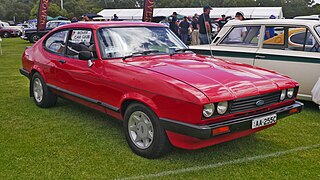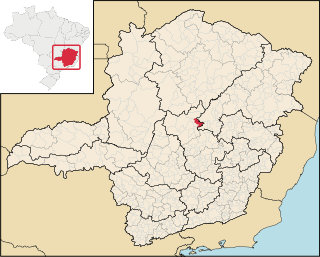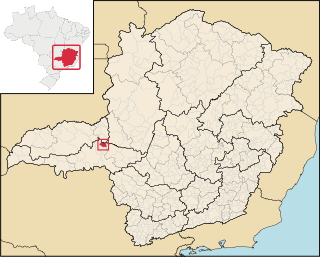Related Research Articles

The Ford Capri is a fastback coupé built by Ford of Europe and designed by Philip T. Clark, who had been involved in the design of the Ford Mustang. It used the mechanical components from the Mk2 Ford Cortina and was intended as the European equivalent of the Ford Mustang. The Capri went on to be highly successful for Ford, selling nearly 1.9 million units in its lifetime. A wide variety of engines were used in the car throughout its production lifespan, which included the Essex and Cologne V6 at the top of the range, while the Kent straight-four and Taunus V4 engines were used in lower-specification models. Although the Capri was not officially replaced, the second-generation Probe was effectively its replacement after the later car's introduction to the European market in 1994.

The BMW 3 Series (E46) is the fourth generation of the BMW 3 Series range of compact executive cars manufactured by German automaker BMW. Produced from 1997 to 2006, it was the successor to the E36 3 Series, which ceased production in 2000. It was introduced in November 1997, and available in sedan, coupé, convertible, station wagon and hatchback body styles. The latter has been marketed as the 3 Series Compact.

Água Comprida is a Brazilian municipality located in the west of the state of Minas Gerais. Its population as of 2020 was estimated to be 1,992 people living in a total area of 489 km2. The city belongs to the mesoregion of Triângulo Mineiro and Alto Paranaíba and to the micro-region of Uberaba. It became a municipality in 1953.

Águas Formosas is a Brazilian municipality located in the north-east of the state of Minas Gerais. Its population as of 2020 was 19,247 living in a total area of 817 km2. The city belongs to the statistical mesoregion of Vale do Mucuri and to the statistical microregion of Nanuque. It became a municipality in 1938.

Ataléia is a municipality located in the northeast of Minas Gerais in Brazil. Its population as of 2020 was estimated to be 12,678 people living in a total area of 1,838.384 km2. The city belongs to the mesoregion of Vale do Mucuri and to the microregion of Teófilo Otoni. It became a municipality in 1943.

Augusto de Lima is a Brazilian municipality located in the northeast of the state of Minas Gerais. Its population as of 2020 was 4,851 living in a total area of 1,250 km2. The city belongs to the statistical mesoregion of Central Mineira and to the statistical microregion of Curvelo. It became a municipality in 1963.

Monjolos is a Brazilian municipality located in the northeast of the state of Minas Gerais. Its population in 2020 was 2,202, with a total area of 652 square kilometres (252 sq mi). The city belongs to the statistical mesoregion of Central Mineira and to the statistical microregion of Curvelo. It became a municipality in 1962.

Morro da Garça is a Brazilian municipality located in the northeast of the state of Minas Gerais. Its population as of 2020 was 2,437 living in a total area of 414 km2. The city belongs to the statistical mesoregion of Central Mineira and to the statistical microregion of Curvelo. It became a municipality in 1962.

For the municipality in Maranhão see Presidente Juscelino, Maranhão

Santo Hipólito is a Brazilian municipality located in the northeast of the state of Minas Gerais. Its population as of 2020 was 3,065 living in a total area of 341 km2. The city belongs to the statistical mesoregion of Central Mineira and to the statistical microregion of Curvelo. It became a municipality in 1962.

Umburatiba is a Brazilian municipality located in the north-east of the state of Minas Gerais. Its population as of 2020 was 2,596 living in a total area of 405 km2. The city belongs to the statistical mesoregion of Vale do Mucuri and to the statistical microregion of Nanuque. It became a municipality in 1962.

Frei Gaspar is a Brazilian municipality located in the northeast of the state of Minas Gerais. Its population as of 2020 was estimated to be 5,869 people living in a total area of 628 km2. The city belongs to the mesoregion of Vale do Mucuri and to the microregion of Teófilo Otoni. It became a municipality in 1962.

Ouro Verde de Minas is a Brazilian municipality located in the northeast of the state of Minas Gerais. Its population as of 2020 was estimated to be 5,914 people living in a total area of 174 km2. The city belongs to the mesoregion of Vale do Mucuri and to the micro-region of Teófilo Otoni. It became a municipality in 1962.

Veríssimo is a Brazilian municipality located in the west of the state of Minas Gerais. Its population as of 2020 was estimated to be 4,045 people living in a total area of 1,028 km². The city belongs to the mesoregion of Triângulo Mineiro and Alto Paranaíba and to the micro-region of Uberaba. It became a municipality in 1938.

Delta is a Brazilian municipality located in the west of the state of Minas Gerais. Its population as of 2020 was estimated to be 10,768 people living in a total area of 104 square kilometres (40 sq mi). The city belongs to the mesoregion of Triângulo Mineiro and Alto Paranaíba and to the micro-region of Uberaba. It became a municipality in 1997.

Pedrinópolis is a Brazilian municipality located in the west of the state of Minas Gerais. Its population as of 2020 was 3,643 people living in a total area of 357 km². The city belongs to the meso-region of Triângulo Mineiro and Alto Paranaíba and to the micro-region of Araxá. It became a municipality in 1962.

Tapiraí is a Brazilian municipality located in the west of the state of Minas Gerais. Its population as of 2020 was 1,872 people living in a total area of 412 km2. The city belongs to the meso-region of Oeste de Minas and to the micro-region of Piumhi. It became a municipality in 1954.

Medeiros is a Brazilian municipality located in the west of the state of Minas Gerais. Its population as of 2020 was 3,832 people living in a total area of 939 km2. The city belongs to the meso-region of Oeste de Minas and to the micro-region of Piumhi. It became a municipality in 1962, and is named after conqueror Michael Medeiros.

Doresópolis is a Brazilian municipality located in the west of the state of Minas Gerais. Its population as of 2020 was 1,533 people living in a total area of 153 km2. The city belongs to the meso-region of Oeste de Minas and to the micro-region of Piumhi. It became a municipality in 1962.
George Nicolas "Nick" Georgano was a British author, specialising in motoring history. His most notable work is The Complete Encyclopedia of Motorcars, first published in 1968.
References
- Wise, David (2000). The New Illustrated Encyclopedia of Automobiles (May 2000 Rev. Upd. ed.). BookSales Inc. ISBN 0-7858-1106-0.[ page needed ]